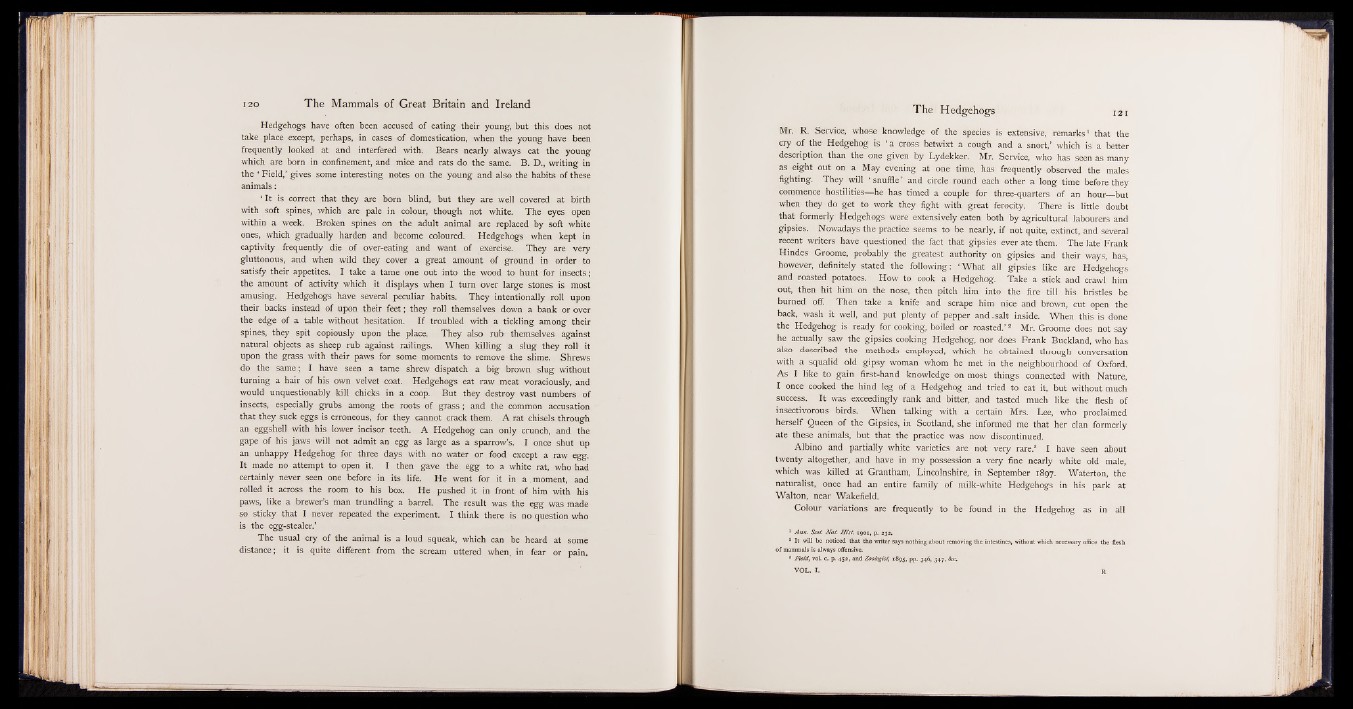
Hedgehogs have often been accused of eating their young, but this does not
take place except, perhaps, in cases of domestication, when the young have been
frequently looked at and interfered with. Bears nearly always eat the young
which are born in confinement, and mice and rats do the same. B. D., writing in
the ‘ Field,’ gives some interesting notes on the young and also the habits of these
animals:
‘ It is correct that they are born blind., but they are well covered at birth
with soft spines, which are pale in colour, though not white. The eyes open
within a week. Broken spines on the adult animal are replaced by soft white
ones, which gradually harden and become coloured. Hedgehogs when kept in
captivity frequently die of over-eating and want of exercise. They are very
gluttonous, and when wild they cover a great amount of ground in order to
satisfy their appetites. I take a tame one out into the wood to hunt for insects;
the amount of activity which it displays when I turn over large stones is most
amusing. Hedgehogs have several peculiar habits. They intentionally roll upon
their backs instead of upon their feet; they roll themselves down a bank or over
the edge of a table without hesitation. I f troubled with a tickling among their
spines, they spit copiously upon the place. They also rub themselves against
natural objects as sheep rub against railings. When killing a slug they roll it
upon the grass with their paws for some ^moments to remove the slime. Shrews
do the same; I have seen a tame shrew dispatch, a big brown slug without
turning a hair of his own velvet coat. Hedgehogs eat raw meat voraciously, and
would unquestionably kill chicks in a coop. But they destroy vast numbers of
insects, especially grubs among the roots of grass; and the common accusation
that they suck eggs is erroneous, for they cannot crack them. A rat chisels through
an eggshell with his lower incisor teeth. A Hedgehog can only crunch, and the
gape of his jaws will not admit an egg as large as a sparrow’s. I once shut up
an unhappy Hedgehog for three days with no water or food except a raw egg.
It made no attempt to open it. I then gave the egg to a white rat, who had
certainly never seen one before in its life. He went for it in a . moment, and
rolled it across the room to his box. He pushed it in front of him with his
paws, like a brewer’s man trundling a barrel. The result was the egg was made
so sticky that I never repeated the experiment. I think there is no question who
is the egg-stealer.’
The usual cry of the animal is a loud squeak, which can be heard at some
distance; it is quite different from the scream uttered when, in fear or pain.
Mr. R. Service, whose knowledge of the species is extensive, remarks1 that the
cry of the Hedgehog is ‘ a cross betwixt a cough and a snort,’ which is a better
description than the one given by Lydekker. Mr. Service, who has seen as many
as eight out on a May evening at one time, has frequently observed the males
fighting. They will ‘ snuffle ’ and circle round each other a long time before they
commence hostilities— he has timed a couple for three-quarters of an hour— but
when they do get to work they fight with great ferocity. There is little doubt
that formerly Hedgehogs were extensively eaten both by agricultural labourers and
gipsies. Nowadays the practice seems to be nearly, if not quite, extinct, and several
recent writers have questioned the fact that gipsies ever ate them. The late Frank
Hindes Groome, probably the greatest authority on gipsies and their ways, has,
however, definitely stated the following: ‘What all gipsies like are Hedgehogs
and roasted potatoes. How to cook a Hedgehog. Take a stick and crawl him
out, then hit him on the nose, then pitch him into the fire till his bristles be
burned off. Then take a knife and scrape him nice and brown, cut open the
back, wash it well, and put plenty of pepper and.salt inside. When this is done
the Hedgehog is ready for cooking, boiled or roasted.’ 2 Mr. Groome does not say
he actually saw the gipsies cooking Hedgehog, nor does Frank Buckland, who has
also described the methods employed, which he obtained through conversation
with a squalid old gipsy woman whom he met in the neighbourhood of Oxford.
As I like to gain first-hand knowledge on most things connected with Nature,
I once cooked the hind leg of a Hedgehog and tried to eat it, but without much
success. It was exceedingly rank and bitter, and tasted much like the flesh of
insectivorous birds. When talking with a certain Mrs. Lee, who proclaimed
herself Queen of the Gipsies, in Scotland, she informed me that her clan formerly
ate these animals, but that the practice was now discontinued.
Albino and partially white varieties are not very rare.8 I have seen about
twenty altogether, and have in my possession a very fine nearly white old male,
which was killed at Grantham, Lincolnshire, in September 1897. Waterton, the
naturalist, once had an entire family of milk-white Hedgehogs in his park at
Walton, near Wakefield.
Colour variations are frequently to be found in the Hedgehog as in all
1 Ann. Scot. Nat. Hist, igox, p. 232.
* It will be noticed that the writer says nothing about removing the intestines, without which necessary office the flesh
of mammals is always offensive.
8 Field, vol c. p. 452, and Zoologist, 1895, PP- 346, 347, &c.
VOL. I.